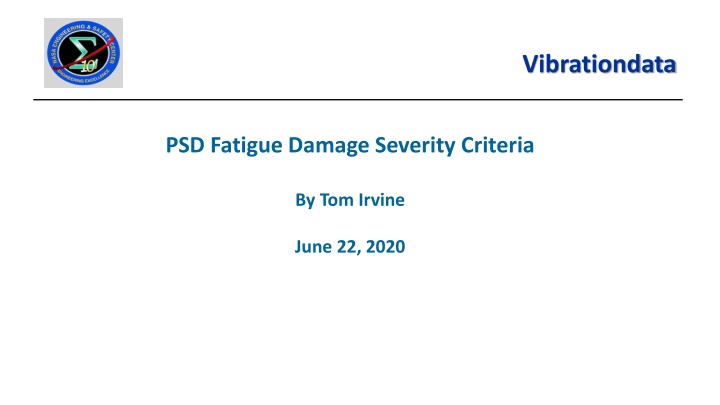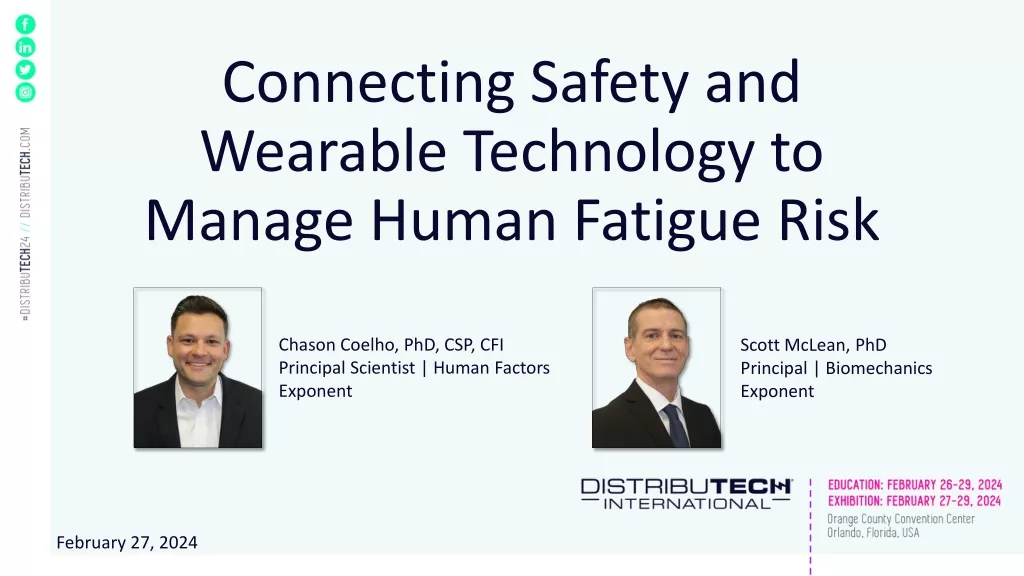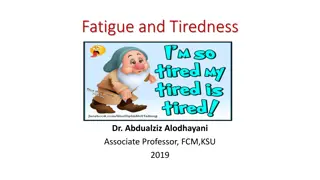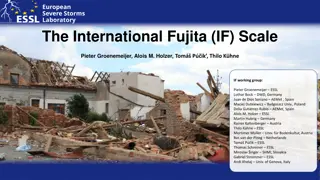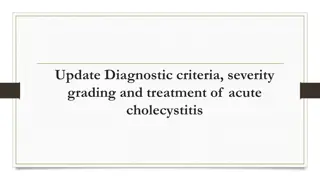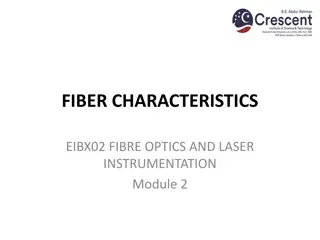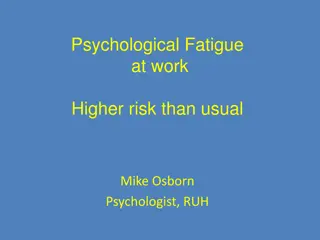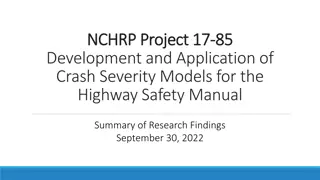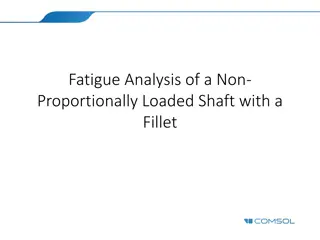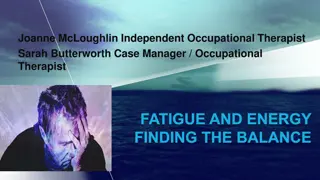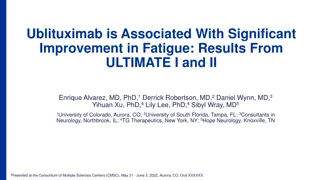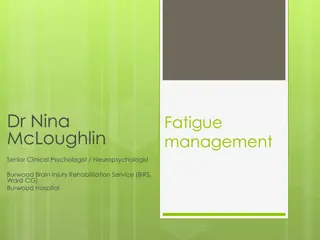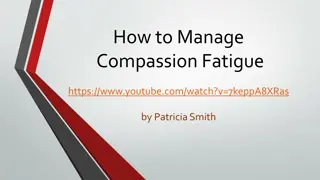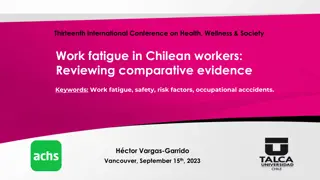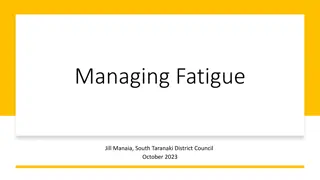Vibrationdata PSD Fatigue Damage Severity Criteria
The method recommended for components tested to PSD specifications on shaker tables. It provides velocity severity categories for Stress-Velocity Relationship (SVR) fatigue damage, aiding in design and analysis efforts to ensure component pass PSD tests. Drawing from experts such as Gaberson, Steinberg, Morse, and Dirlik, the method's innovation includes substituting pseudo velocity for stress in Dirlik calculation. Learn about Howard Gaberson, a notable shock and vibration specialist with over 45 years of dynamics experience in Navy and Facilities Engineering Service Center.
Download Presentation

Please find below an Image/Link to download the presentation.
The content on the website is provided AS IS for your information and personal use only. It may not be sold, licensed, or shared on other websites without obtaining consent from the author.If you encounter any issues during the download, it is possible that the publisher has removed the file from their server.
You are allowed to download the files provided on this website for personal or commercial use, subject to the condition that they are used lawfully. All files are the property of their respective owners.
The content on the website is provided AS IS for your information and personal use only. It may not be sold, licensed, or shared on other websites without obtaining consent from the author.
E N D
Presentation Transcript
Vibrationdata PSD Fatigue Damage Severity Criteria By Tom Irvine June 22, 2020
Vibrationdata Introduction The following method is intended for components which are to be tested to power spectral density (PSD) specifications on shaker tables The method can be applied to sine-on-random specifications as well The purpose of this document is to recommend velocity severity categories for PSD base inputs in terms of Stress-Velocity Relationship (SVR) fatigue damage The categories can then be used to plan the design and analysis efforts required to ensure that a component will pass its PSD test, or at least mitigate risk of failure with associated cost and schedule delays The method draws from Gaberson, Steinberg, Morse and Dirlik The 50 ips velocity line is typically plotted on SRS specifications as a reference severity threshold, based in part on the SVR The SVR is a global method (Gaberson) for predicting the maximum stress in a structure due to shock & vibration as given at: https://vibrationdata.wordpress.com/2013/04/15/howard-gaberson-papers/
Vibrationdata Introduction (continued) The Dirlik method calculates the fatigue damage from a response PSD as given at: https://vibrationdata.wordpress.com/2013/11/08/dirlik-rainflow-counting-method-from-response-psd/ An innovation of this report is to substitute pseudo velocity for stress in the Dirlik calculation, since Gaberson showed that velocity is proportional to stress Effectively, an S-N curve is transformed into a PV-N curve where a velocity limit such as 50 ips is substituted for the ultimate stress limit The PV-N curve has a fatigue exponent and is a straight line in log-log format The method takes a roundabout approach by adjusting the ultimate velocity limit so that the cumulative fatigue index is one which is the fatigue failure threshold This adjusted limit is then the minimum velocity which the component must be able to withstand in order to pass the test
Howard Gaberson Vibrationdata Howard A. Gaberson (1931-2013) was a shock and vibration specialist with more than 45 years of dynamics experience He was with the U.S. Navy Civil Engineering Laboratory and later the Facilities Engineering Service Center from 1968 to 2000, mostly conducting dynamics research Gaberson specialized in shock and vibration signal analysis and has published more than 100 papers and articles
Avionics Components Vibrationdata Electronic components in vehicles are subjected to shock and vibration environments The components must be designed and tested accordingly Dave S. Steinberg s Vibration Analysis for Electronic Equipment is a widely used reference in the aerospace and automotive industries
Some General Caveats Vibrationdata Vibration calculations given uncertainties in S-N curves, stress concentration factors, non-linearity, temperature, surface finish, load sequence, multi-axis loading and other variables. fatigue calculations are ballpark Perhaps the best that can be expected is to calculate the accumulated fatigue to the correct order-of- magnitude. 6
Pseudo Velocity Vibrationdata A = absolute acceleration response of an SDOF System PV = pseudo velocity Z = relative displacement between mass and base input = angular natural frequency The relative displacement is: Z = X -Y The preferred method of calculating pseudo velocity is: PV = Z Another, approximate method is: PV A / Also note: A 2Z As an example, calculate the acceleration corresponding to a pseudo velocity of 50 in/sec at 100 Hz A PV A ( 2 )(100 Hz)( 50 in/sec ) ( 1 G / 386 in/sec^2) = 81 G 7
Vibrationdata Shock Severity Limit An empirical rule-of-thumb in MIL-STD-810E states that a shock response spectrum is considered severe only if one of its components exceeds the level: Threshold = [ 0.8 (G/Hz) * Natural Frequency (Hz) ] For example, the severity threshold at 100 Hz would be approximately 80 G This rule is effectively a velocity criterion MIL-STD-810E states that it is based on unpublished observations that military-quality equipment does not tend to exhibit shock failures below a shock response spectrum velocity of 100 inches/sec (254 cm/sec) The above actually corresponds to 50 inches/sec It thus has a built-in 6 dB margin of conservatism Note that this rule was not included in MIL-STD-810F or G, however 8
Vibrationdata Shock Severity Limit (cont) SMC-TR-06-11 AEROSPACE REPORT NO. TR-2004(8583)-1 REV. A, Test Requirements for Launch, Upper-Stage, and Space Vehicles, Section 10.2.6 Threshold Response Spectrum for Shock Significance A response velocity to the shock less than 50 inches/second is judged to be non-damaging This is the case if the shock response spectrum value in G is less than 0.8 times the frequency in Hz 9
Vibrationdata 100 ips Threshold The 100 ips threshold is defined in part by the observation that the severe velocities which cause yield point stresses in mild steel beams turn out to be about 130 ips Mild Steel Yield stress is: 36 ksi Speed of sound in Steel is: c = 200,000 ips = 0.0007512 lbf sec^2/in^4 khat = sqrt(3) for beam with rectangular cross-section Vmax = (yield stress)/(khat * * c) = 130 ips for beam (rounded slightly downward) = 36,000 lbf/in^2 /( sqrt(3) * 0.0007512 lbf sec^2/in^4 * 200,000 ips) 10
Vibrationdata Pseudo Velocity Riskometer Risk Category PV (ips) Low PV < 100 Moderately Low 100 < PV < 150 Moderate 150 < PV < 200 Moderately High 200 < PV < 250 High PV > 250 The pseudo velocity is calculated at the natural frequency if the frequency is known Otherwise, the pseudo velocity is the peak value for a family of natural frequencies between estimated lower and upper frequency limits Extra analysis and design precautions are needed as the needle turns clockwise Assigning these extra steps by risk category is currently beyond the scope of this effort But some general guidelines are given later in this document 11
Morse Severity Limits Vibrationdata SHOCK RESPONSE SPECTRA - DAMAGE THRESHOLDS 105 Probable Damage 300 ips Potential Damage 100 ips Failure unlikely below this limit 50 ips 104 The pseudo velocity limits on the previous slide are loosely based on the Morse chart PEAK ACCEL (G) 103 102 101 100 10 100 1000 10000 NATURAL FREQUENCY (Hz) R. Morse, Spacecraft & Launch Vehicle Dynamics Environments Workshop Program, Aerospace Corp., El Segundo, CA, June 2000 12
Hypothetical PV-N Fatigue Curve Vibrationdata A component s ultimate limit and fatigue exponent depend on the material, geometry, stress concentration and myriad other factors Ideally, these variables could be measured Engineering judgment can be cautiously used as needed to estimate these variables otherwise The pseudo velocity threshold line equation is: PV = [ ( PVult )b / N ]1/b where PV ult = PV threshold at 1 cycle N = number of cycles b = fatigue exponent 13
Vibrationdata Parameters The base input PSD and duration are both independent variables The test item is assumed to be an SDOF system with three variables: natural frequency, amplification factor and fatigue exponent The natural frequency can be set to a specific value or allowed to vary in between two limits, as previously mentioned Conservative values can be set for the amplification factor Q and fatigue exponent b But some test cases have shown that conservative Q & b values indicate fatigue failure even at lower PSD test levels Recommended moderate values are Q=20 & b=6.4 The b=6.4 value comes from Steinberg s Vibration Analysis for Electronic Equipment Actual Q & b values for the test item can be used but are seldom known Matlab scripts are used to calculate the pseudo velocity that the test item needs to withstand in terms of fatigue for the given set of input parameters The velocity is then referenced to a risk category as shown in the previous Riskometer slide 14
Vibrationdata Sample Input PSD The SMC-S-016 PSD is used as the PSD base input in the following examples with a duration of 750 sec The fact that it represents minimum workmanship is irrelevant for the example The PSD level is also increased by uniform dB levels to study the variation between fatigue and input level 15
Vibrationdata VRS for SMC-S-016 Base Input PSD The peak curve is based on the Rayleigh distribution of the response peaks and is the only curve dependent on duration 16
Vibrationdata Results Minimum Velocity Limit (ips) Input PSD Input Overall GRMS Risk Category SMC-S-016 6.9 68 Low Risk SMC-S-016 +6 dB 13.8 136 Moderately Low Risk SMC-S-016 +12 dB 27.6 271 High Risk SMC-S-016 +18 dB 55.1 540 High Risk The threshold is based on a Palmgren-Miner cumulative damage index of 1 The frequency spacing is 1/24th octave between the 20 and 2000 Hz limits The component must have the ability to withstand the minimum velocity in order to pass the random vibration test The Minimum Limit is actually the maximum velocity for the family of natural frequency cases The worst-case natural frequency was 145.8 Hz for each of the cases in the table The limits would be lowered if the natural frequency was known to have some spacing away from 145.8 Hz The Risk Category is intended as a rough guide for determining the level of analysis needed as well as for design precautions 17
Vibrationdata Left to Right: Turan Dirlik, Tom Irvine, Curtis Larsen International Conference on Engineering Vibration, Ljubljana, Slovenia, 2015 18
APPENDIX A Sine-on-Random Example 19
Vibrationdata SMC-S-016 Base Input PSD + Sine Tones The sine tones are (200 Hz, 12 G) & (400 Hz, 6 G) The duration is 750 seconds This combined specification is for demonstration purposes only The analysis is performed by synthesizing a sine-on-random time history The synthesis duration is 60 seconds A 12.5 multiplier is used in the fatigue calculation to scale the damage from 60 to 750 secons Then the fatigue analysis is performed in the time domain using rainflow cycle counting 20
Vibrationdata Synthesized Time History & PSD 21
Vibrationdata Sine-on-Random Time History Full and Close-up Views Next calculate VRS and then perform ASTM E 1049-85, section 5.4.4, Rainflow Counting 22
VRS Vibrationdata 1/24th octave spacing 23
Results, Sine-on-Random, Selected Natural Frequency Cases The input time history is: SMC-S-016 + Sine Tones, 11.7 GRMS overall The table shows the importance of design a component so that its natural frequency is way from the 200 Hz sine tone Natural Frequency (Hz) Minimum Velocity Limit (ips) Risk Category 20 to 2000 479 High risk 20 to 150 83.4 Low risk 250 to 2000 147 Moderately low risk 24
APPENDIX B Pseudo Velocity Limit Notes & Design Tips 25
Pseudo Velocity Limit Notes Vibrationdata The results in the previous table are particularly useful if the velocity limits of the component s materials are known Some components such as avionics boxes have piece parts with unknown velocity limits, as well as unknown fatigue exponents Steinberg has established fatigue analysis techniques for circuit boards which are included in: https://vibrationdata.wordpress.com/2013/02/15/extending-steinbergs-fatigue-method/ A program could decide for example that a certain avionics box be subjected to a Steinberg analysis if its risk category for a given PSD is moderate or greater A program might also decide that a metallic, mechanical component be subjected to a finite element analysis depending on its risk category The decision for further analysis in each case should also be based on the criticality of the component Some design tips for components subjected to, say, moderate or higher risk velocities are given in the next slides 26
Material Limits Vibrationdata Yield Stress (ksi) E rho C V Rod (in/sec) V Beam (in/sec) V Plate (in/sec) Material (psi) (lbm^3) (in/sec) Aluminum 6061-T6 35 10e+06 0.1 1.96e+05 695 402 347 Aluminum 7075-T6 66 10e+06 0.1 1.96e+05 1300 751 650 Magnesium AZ80A-T5 38 6.5e+06 0.065 1.96e+05 1015 586 507 CRES 303 60 28e+06 0.289 1.93e+05 414 239 207 A286 40 29e+06 0.286 1.98e+05 273 158 136 Monel K500 40 26e+06 0.305 1.81e+05 279 161 140 Monel 400 25 26e+06 0.318 1.78e+05 171 99 85 Inconel 625 40 30e+06 0.305 1.95e+05 260 150 130 Inconel 718 100 30e+06 0.296 1.98e+05 659 381 330 27
Common Notes for Electronic & Mechanical Components Tune the component s natural frequency away from the dominant base input MPE frequency to mitigate resonant response The tuning is achieved by changing the mass, stiffness or geometry Add damping mechanisms to control resonant response Design the component with isolator mounts if possible The isolators can be wire rope or elastomeric bushings or grommets Determine whether the component can moved to a location in the vehicle with a lower base input MPE PSD NASA/JPL, Mars Science Laboratory Sensor Support Electronics mounted on wire rope isolators Use proven, flight heritage components if possible 28
Mechanical Components Vibrationdata Parts should be designed to minimize stress concentration factors Changes in cross-section should have smooth transitions Metallic part edges should have either chamfers or fillets rather than sharp edges to reduce stress concentration Fillets give superior mitigation although a chamfer may be sufficient in most cases Select materials with high fracture toughness and slow crack growth Choose proper surface finishes, such as polishing to prevent small surface scratches Shot peening and cold rolling are good for the fatigue life in general Avoid metallic plating with widely different properties than underlying material 29
Electronic Components Vibrationdata Use Mil-Spec piece parts rather than commercial-off-the-shelf ones Medium and larger size piece parts should be staked down to the circuit board using epoxy, silicone or some other adhesive to prevent the part from detaching Thick conformal coating of the entire board is beneficial for reducing the vibration response by adding damping, although this makes rework difficult Electromagnetic relays are prone to chatter, so use solid state switches if possible The highest deflection will usually occur at the center of the circuit board, and this zone should be reserved for smaller, lighter parts Heavier parts should be mounted along the outer perimeter IC socket mounts should not be used in avionics due to the potential of the IC to dislodge 30
Electronic Parts, Lesson Learned from another Rocket Program The oscillator is bent over so that it is parallel to the board The oscillator's structural response is similar to a cantilever beam Then it is staked down with an RTV or epoxy compound Resonant excitation may occur during shock and vibration Furthermore, a Mil-Spec oscillator should be used rather than a commercial part High stress levels may develop in the crystal and in the leads as a result 31
